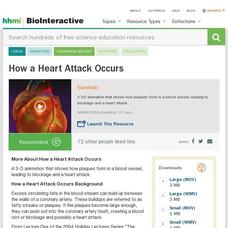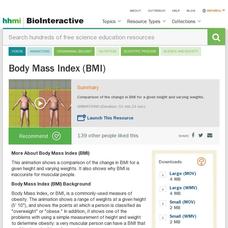Howard Hughes Medical Institute
Sickle Cell Anemia
The most common blood disorder in the United States, sickle cell impacts more than 70,000 Americans. Understanding the genetic coding that leads to this disease might one day help scientists prevent it altogether. Using a promising...
Howard Hughes Medical Institute
Shotgun Sequencing
Finally, something that is better when it's broken! Computers make sequencing short pieces of genome an easy task, yet they struggle with long sequences. Learn about one method for sequencing genomes by breaking it into smaller pieces...
Crash Course
Darwin and Natural Selection: Crash Course History of Science #22
Charles Darwin studied many species, but he also hindered their continued study by eating his specimens. Like many sailors, he enjoyed the taste of the Galapagos tortoise so much for many years that no ship made it all the way back to...
Howard Hughes Medical Institute
Pocket Mouse Evolution
G.H. Hardy and Wilhelm Weinberg created a mathematical formula to predict genotype frequencies. Observe a simulation of the Hardy-Weinberg equation using pocket mice. Scholars consider the selection coefficient, selective advantage, and...
Howard Hughes Medical Institute
How a Heart Attack Occurs
Heart disease causes more deaths in both men and women in the United States than any other factor, buy many people don't fully understand what causes a heart attack. A brief animation demonstrates the slow buildup of plaque, a blockage...
Howard Hughes Medical Institute
Body Mass Index (BMI)
Know your number! Diabetes and heart disease both increase with higher body mass index numbers. Understanding the body mass index (BMI) helps scholars take control of their own health. They view a comparison of what various BMI...
Howard Hughes Medical Institute
Translation (Basic Detail)
RNA translates three letters at a time to create a perfect protein chain. With the help of an animation, viewers discover the process of translation in real time. From ribosome to protein, the program creating living things finds...
Howard Hughes Medical Institute
Sanger Method of DNA Sequencing
Fred Sanger created the first method of sequencing DNA in 1977 using chemical alterations. Learn more about the Sanger method with a brief animation demonstrating the replication, ordering, and piecing together steps in the process.
PBS
When We First Walked
Out of all mammals, only humans walk on two feet. Discuss the current scientific understanding of when this specific adaptation began. A video shares facts about many different species and theories about why the shift occurred. New...
PBS
Life, Sex, and Death Among the Dire Wolves
Scientists know a great deal about extinct dire wolves thanks to a large number fossilized in one geographical area. They lived in groups, hunted opportunistic or wounded prey, and were fierce in battle and sex. Learn more with an...
TED-Ed
Could the Earth Be Swallowed By a Black Hole?
A black hole exists only a couple of thousand light years away from Earth. Should we be scared, or does that mean we are safe? Learn about the perspective of black holes and their relationship with Earth and the larger universe. After...
TED-Ed
What Would Happen If Every Human Suddenly Disappeared?
Humans constantly change the earth by building things, using natural resources, and relocating plants and animals. The lesson considers would happen to the planet if humans were gone. The narrator discusses the changes in buildings and...
PBS
When Fish Wore Armor
Today very few animals exist with both an endoskeleton and exoskeleton. Yet, in the Devonian period, a large number of fish species lived with both. Scientists debate if they were for protection or mineral storage, because none of them...
PBS
Killer Landslides | Monitoring and Predicting Landslides
Landslides kill between 25 and 50 people every year in the United States alone. This is why predicting a landslide literally saves lives. A scientist applied new technology to a mountain and accurately predicted a landslide. Thanks to...
Crash Course
Earth Science: Crash Course History of Science #20
How old is Earth and how do scientists know the answer? Throughout history, many researchers, scholars, and leaders answered this question with varying degrees of accuracy. The 20th episode of Crash Course History of Science introduces...
PBS
The Rise and Fall of the Bone-Crushing Dogs
Fun fact: giant, bear-sized dogs with teeth that crush bones existed in North America. Learn about the three species of dogs and their ultimate fates as cats moved into the area. An informative video describes the rise of all three...
PBS
How a Supervolcano Made the Cenozoic’s Coolest Fossils
Volcanoes cause mass extinctions, climate change, and physical alterations of our planet. They also create great fossil records, time markers in layers of Earth, and an interesting way to study geology. A video describes how one...
PBS
When Birds Had Teeth
Scientists believe confuciusornis developed a beak and lost teeth as a key step in the evolutionary process. Learn more about confuciusornis and other birds, dinosaurs, and animals that evolved into the birds of today. PBS Eons walks...
PBS
When Insects First Flew
Insects developed wings and the ability to fly earlier than any other animal—when exactly did that happen? Scientists know this fact but struggle to explain when insect wings developed and how this entirely new structure appeared. PBS...
PBS
FAQs From Our First Year
After a year of PBS Eons videos, viewers raised some excellent points and questions. The hosts highlight the most common including classification of animals, when a new eon starts, how to pronounce scientific terms, and many other...
PBS
How the T-Rex Lost Its Arms
The Tyrannosaurs Rex grew up to 20 feet tall, yet their front arms were roughly the size of human arms—hardly proportional! Viewers see how the front limbs became smaller over the course of millions of years. PBS Eons goes on to explain...
PBS
How Horses Took Over North America (Twice)
Should horses be considered native to North America? PBS Eons presents the fossil record to answer this question. the video starts with the evolution of animals that eventually led to the family scientists now know includes horses. Then,...
PBS
The Mystery of the Eocene’s Lethal Lake
One lake in Germany killed everything that swam in it, drank from it, or flew over it providing scientists with an incredible fossil record and a huge mystery. PBS Eons explains the rarity of the fossil finds including turtles in the...
PBS
When Fish First Breathed Air
Many species find breathing a convenient way to survive. The PBS Eons series explains how fish learned to breathe air. It details what scientists know about evolutionary history as well as many species that developed this skill...























